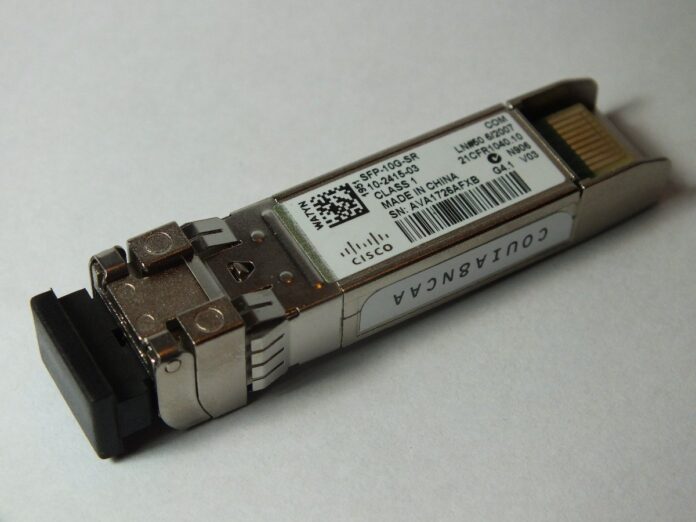The optical module is an optoelectronic system that can realize optical/electrical and electrical/optical conversion, has independent transmit drive and receive amplifier circuits, and conform to telecommunication transmission standards. Since its inception around 1999, the optical transceiver module has become the core optical device of the interface part of various optical communication systems. At present, the technology of optical transceiver module is developing towards miniaturization, intelligence and high speed. Intelligent XFP optical modules, 10G optical modules and parallel optical fiber modules have become the highlights of the new generation of optical transceiver modules. At present, 10G optical transceiver modules mainly include 300pin, XENPAK. X2, Xpak and XFP,SFP+ etc.
1) 300pin
300pin is the first generation of 10G optical modules. It follows the 300-pin Multi-source Agreement (MSA) and was originally designed for SDH networks. It is large in size and relatively expensive.
2) Xenpak optical module
Xenpak is the earliest optical module for 10G Ethernet. Its functional block diagram is shown in Figure 2-1, which corresponds to the 10G media independent interface extension sublayer (XGXS), PCS, and physical media additional sublayer (PMA) in the IEEE 802.3ae standard. ) and the functions of the Physical Media Dependent sublayer (PMD).
3) XFP optical module
The leading manufacturer that competes with the Xenpak camp is Finisar in the United States, which unites about 10 companies, including system integrators Brocade> Emulex> ONCiena, optical module providers Finisar, JDSU, Sumitomo Electric> Tyco Electronics and chip manufacturers Broadcom, Maxim, Velio et al. established the XFP Multi-Source Agreement Organization (MSA) in March 2002. Compared with other optical modules, XFP is the most compact and cheapest optical module, so it has great advantages. XFP has been considered as a new generation product after Xpak or X2, and many manufacturers have released their own XFP optical module products.
Compared with several other optical modules, XFP is an optical transceiver (Transceiver), not an optical transceiver module (Transponder). The optical transceiver is actually just a photoelectric conversion device, which is only responsible for completing the conversion of optical/electrical signals. Other functions such as Multiplexing/demultiplexing, 64B/66B codec, etc. are implemented by chips on the circuit board. XFP optical modules can easily achieve high-end density applications. Since XFP occupies only 20% of the blood volume of the printed circuit board (PCB) and the power consumption is only 1.5~2W, it can be used to implement line cards with up to 16 ports.
The interface between XFP and circuit board adopts 10G serial circuit interface (XFI) O. Now some manufacturers have provided XSBI-to-XFI and XAUI-to-XFI chips, and XGMII-to-XFI chips are also under development by manufacturers. Compared with Xenpak, although XFP has to work with the physical layer ((PHY) chip, it still saves the XGXS in the middle
At present, since Xenpak optical modules are the first to be introduced to the market, the technology is relatively mature, and there are many chips that provide XAUI interfaces, so they are widely used. Although Xpak and X2 are only half the size of Xenpak in volume, their cost is also higher than that of Xenpak optical modules, so they can only appear as transitional products. Due to the emergence of XFP optical modules and the rapid development of technology, many manufacturers have abandoned the development of Xpak and X2 optical modules and turned directly to XFP optical modules. The XFP module puts the multiplexing/demultiplexing circuit outside the module, thus further reducing the module volume and system cost. The actual size is about 1.5 times that of the current SFP module, so the advantage will be very obvious.
In recent years, the strong competitiveness of XFP in telecom network and storage network makes it more and more favored by device manufacturers. Under the condition that ASIC technology is becoming more and more mature, it is considered to be the most promising 10Gbps optical module technology.
2.2 Monitoring principle of XFP optical module
The management interface of digital diagnosis is the core part of the whole XFP module, and it is also the basis for realizing the module monitoring function. In INF-8077i, Revision 4.5, the digital diagnostic function and related details are defined as shown in Figure 2-3.
2-Wire Serial Address
The 256Byte address space A0 of I2C is divided into low 128Byte and high 128Byte. The lower 128 bits are directly accessed to store the numerical measurement results of 5 analog parameters, calibration parameters, alarm off values and flag bits, control flag bits, status flag bits, interrupt control flags and various circuit parameters. The address unit of the 127th byte is used for other parameters of page selection, avoiding the frequent address space conversion of I2C. These units also define some general basic information, such as company information, production FI period, serial number, module type, wavelength and transmission length, etc., as well as custom state mirroring of individual pins and user-writable storage units. This information is stored in standard memory cells for reading circles via a two-wire serial interface.
When the module is working, the monitoring program of the single-chip microcomputer performs real-time detection on some important parameters of the module and converts them into digital signals, and then displays these digital parameter results on the LCD liquid crystal module in real time, which can be monitored more conveniently. Such as: transmitting optical power TX POWER, receiving optical power RX POWER, temperature TEMP, T as voltage VCC, laser bias current I BIASo
In addition, for the various alarm signs defined, directly set the status indicator light for easy observation:
1) MOD ABS means that Module Absento outputs a high level to indicate that the module does not exist physically.
2) Mod NR means Module Not Ready, the module is not ready. The high level of the output indicates that the transmitter or receiver data is incorrect, if the sending data is out of lock, the received data is out of lock, and the laser of the transmitter is faulty.
3) RX_LOS output high level indicates that the signal is lost and the optical power is too small.
4) Interrupt output low level indicates interruption, the module may malfunction
For the required control bits, set the corresponding configuration switches directly on the circuit board for convenience:
1) Mod_DeSel is Module De-select, the module releases the bus. The I2C serial communication is performed when the input is low, and the module releases the I2C bus when the input is high.
2) TX_Dis is TX Disable. A high level input from an external circuit to this pin means that the laser is turned off.
3) When P_Down/RST is high, it means Power Down function, the module will be set to low power consumption mode, and the power is less than 1.5W. Low level indicates RST function, reset.









![Anso FG Reviews: UPDATED 2024 [ansofg.com] Anso FG Reviews UPDATED 2024 [ansofg.com]](/wp-content/uploads/2023/12/Anso-FG-Reviews-UPDATED-2024-ansofg.com_-100x70.png)








